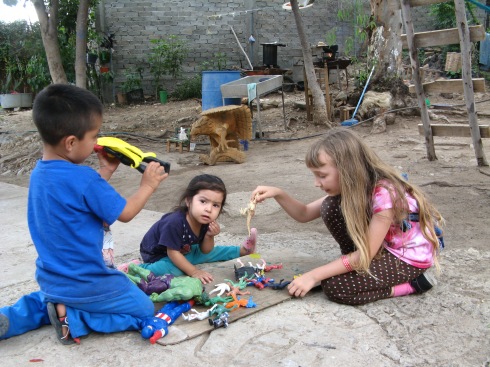Our new friend Sam took us to San Martín Tilcajete, one of the towns famous for alebrijes, figurines (typically animals) that are carved from copal wood and then painted elaborately. His friend Benito Fabian Ortega is one of the artists and his whole family makes them. Six of us piled into a moto taxi–three adults crammed into the back, Munchkin on a lap, and Benito hanging on next to the driver with one hand, holding his toddler daughter on his lap with the other–and went to their workshop/home/gallery. I wasn’t sure if I should photograph their alebrijes, but you can look up the word to see what I mean, and add “Fabian Ortega” to see this family’s amazing artistry.
Here is the munchkin with a menagerie of alebrijes that have been carved, but not yet painted:

Later, Benito’s nephew brought out a different kind of menagerie and he, Benito’s daughter, and Munchkin played with them. I’ve seen a lot of dragon alebrijes but no dinosaurs so far.


You would think they had enough carving to do for the market, but someone couldn’t resist embellishing this tree. The whole compound was like that, an exaggeration of the Mexican tendency to exert creativity and create beauty, whether it be on boundary walls, floor tiles, or what have you. The Jewish concept of the “adornment of a mitzvah,” which I absorbed as an artistically-inclined Jewish child, is more alive in this country than any other I have visited. In Judaism it means that one does not just do what is required (a mitzvah is a commandment) but does it beautifully. All one must do to fulfill the commandment to begin the Sabbath with candles is stick a couple of candles upright and keep them lit for half an hour, but if at all possible, one uses beautiful candlesticks kept just for that weekly purpose; leftovers would be enough to fulfill the obligation to give to the poor, but Maimonides teaches that one should give them one’s best cooking. That generosity of spirit is everywhere in Oaxaca, as it was in San Miguel de Allende, where we lived in 2010.
One of the brothers saw me pointing my camera and said I had to come up on the roof. I thought he meant I’d get a good angle on the yard, which was where I’d been taking pictures, and I did, but he also wanted me to see the view. I swear Oaxaca has a corner on the world’s greatest clouds.


I noticed this hill off to my right and he said it was called Maria Sanchez. “¿Quien era Maria Sanchez?” I asked. He explained that she was a woman who had died there. According to legend, the large hill was her head, the smaller ones off to the left her breasts, and so on. I would have liked to find out more details–how did she die? why was she immortalized in this way?–but I’d been in Oaxaca for only a week at that point, and “rusty” would be a generous term for the state of my Spanish. (It still is, but it gets easier every day to comprehend what people are saying.)
I summoned enough to tell him that in the town I grew up in, Hamden, Connecticut, there is a hill called the Sleeping Giant. It’s the town’s most prominent geographical feature, which lies within a state park of the same name. Climbing one of the giant’s hips to a WPA-built “castle” at the summit was one of the repeated, always fun adventures of my childhood, which I want to repeat with my own daughter on a visit in the not-too-distant future. The college where my father taught is nestled in its shadow; the town likes to refer to itself as “land of the Sleeping Giant,” and I went to Sleeping Giant Junior High School. The giant, as told by the Quinnipiac Indians, is Hobbomock, who wreaked havoc (apparently with good intentions) when he stamped his foot, and was put into a permanent state of sleep by a more peaceable spirit. Our host seemed unsurprised by the similarity, and in fact when I looked up “sleeping giant” to check a couple of details just now, I discovered that there are similar legends in Kauai and Ontario.


2 comments
Comments feed for this article
July 9, 2016 at 8:26 pm
Roger
It’s lovely to see your sabbatical adventures beginning to unfold, Amy. And congratulations on the Skinner Sermon Award. — Chris Schriner
LikeLike
July 11, 2016 at 6:02 am
Amy Zucker Morgenstern
I’ve edited this entry after my friend Jacqui, who is an anthropologist and very knowledgeable about Mexico, pointed out the fallacy of my original statement, “There is next to no Jewish culture in Mexico.” Jewish influence in Mexico looks very different than in the US but it is far from absent. In fact, one wave of immigration from Spain is estimated to have been 75% Jewish, as Jews escaped from oppression and/or were expelled (Judaism was anathematized in Spain at the time, and forced conversion was common).
LikeLike